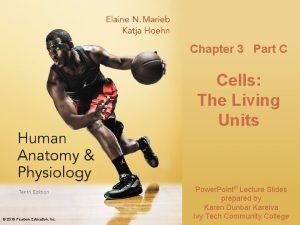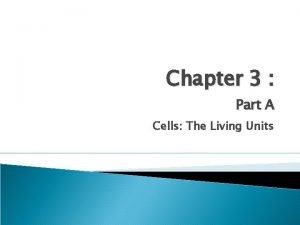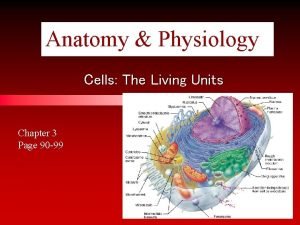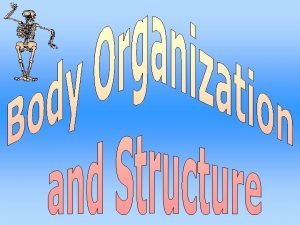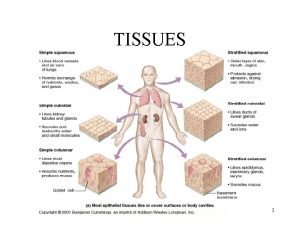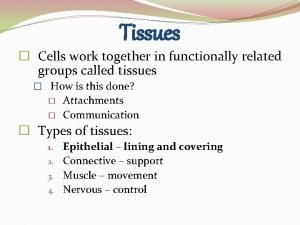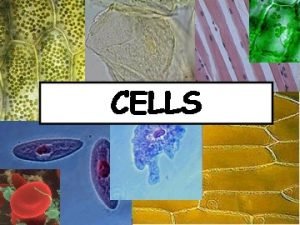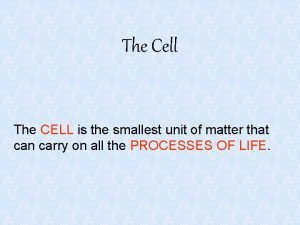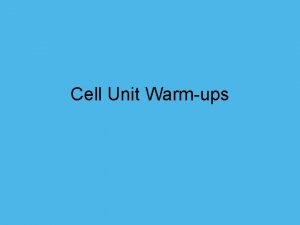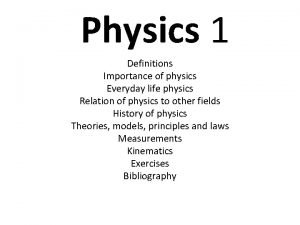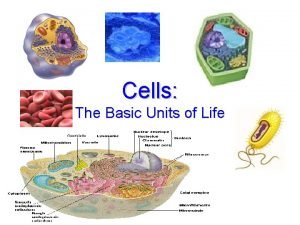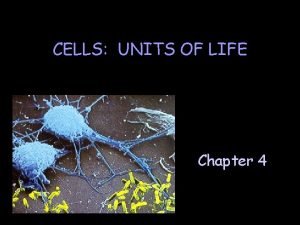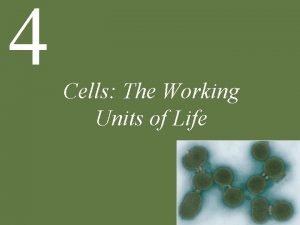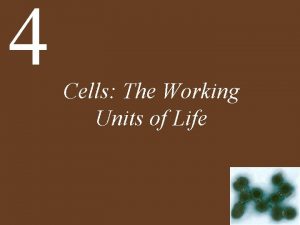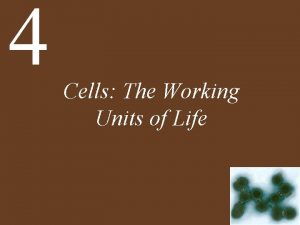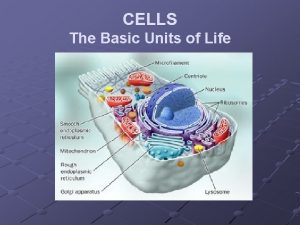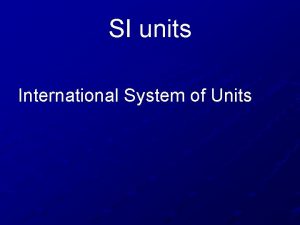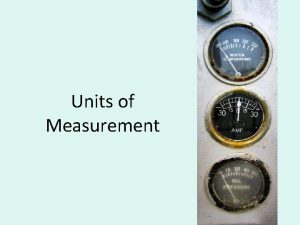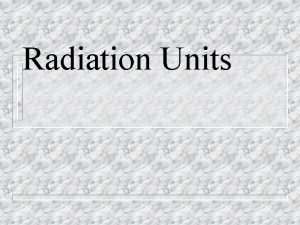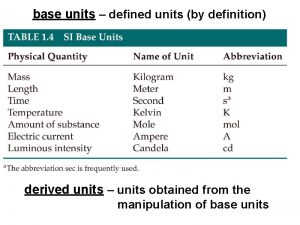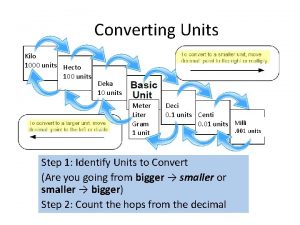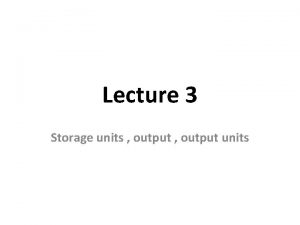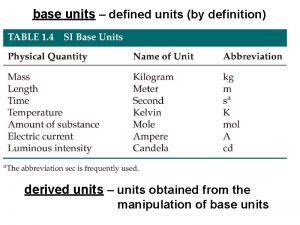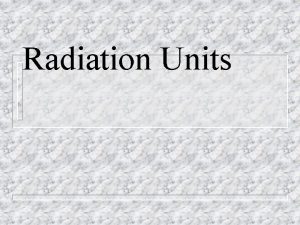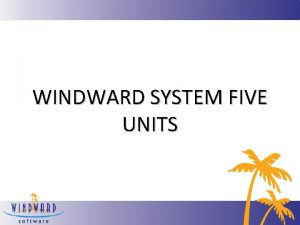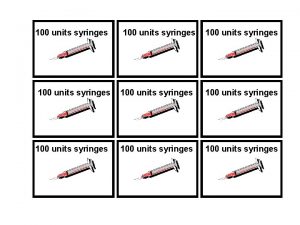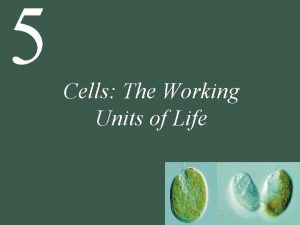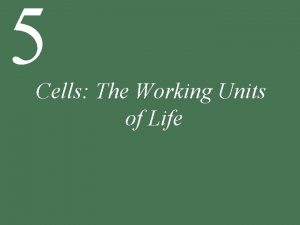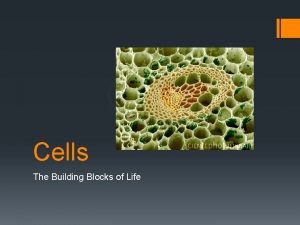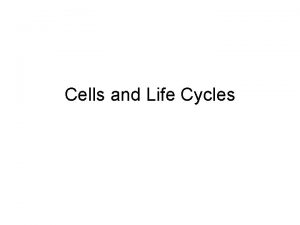Chapter 6 Cells The Working Units of Life




















































- Slides: 52

Chapter 6 Cells: The Working Units of Life PART II AP Biology

Cells: The Working Units of Life • Key Concepts • Cells Provide Compartments for Biochemical Reactions • Prokaryotic Cells Do Not Have a Nucleus • Eukaryotic Cells Have a Nucleus and Other Membrane-Bound Compartments • The Cytoskeleton Provides Strength and Movement • Extracellular Structures Provide Support and Protection For Cells and Tissues

Vacuoles: Diverse Maintenance Compartments • Vacuoles (mainly in plants and fungi) have several functions: • Storage of waste products and toxic compounds; some may deter herbivores. • Structure for plant cells —water enters the vacuole by osmosis, creating turgor pressure. • Food vacuoles: formed by phagocytosis • Contractile vacuoles: pump excess water out of cells; found in many freshwater protists • Central vacuoles: hold organic compounds and water; found in many mature plant cells Copyright © 2008 Pearson Education, Inc. , publishing as Pearson Benjamin Cummings

Fig. 6 -15 Central vacuole Cytosol Nucleus Central vacuole Cell wall Chloroplast 5 µm

Concept 6. 5: Mitochondria and chloroplasts change energy from one form to another • Mitochondria: sites of cellular respiration, a metabolic process that generates ATP • Chloroplasts: found in plants and algae; site of photosynthesis • Mitochondria and chloroplasts o o NOT part of the endomembrane system Have a double membrane Have proteins made by free ribosomes Contain their own DNA • Peroxisomes: oxidative organelles Copyright © 2008 Pearson Education, Inc. , publishing as Pearson Benjamin Cummings

Mitochondria: Chemical Energy Conversion • Mitochondria have two membranes: • Outer membrane—very porous • Inner membrane—extensive folds called cristae increase surface area • The inner membrane creates two compartments: • intermembrane space • mitochondrial matrix • The fluid-filled matrix contains enzymes, DNA, and ribosomes.

Mitochondria: Chemical Energy Conversion

Chloroplasts: Capture of Light Energy • Chloroplast member of family of organelles called plastids • Chloroplast: contains chlorophyll; site of photosynthesis o Photosynthesis converts light energy into chemical energy (anabolic process). o Chloroplasts found in leaves and other green organs of plants & algae

Chloroplasts: Capture of Light Energy • Chloroplasts have two membranes, plus internal membranes called thylakoids. o Granum —a stack of thylakoids; light energy is converted to chemical energy on these membranes. o Stroma —aqueous matrix (fluid) around grana; contains ribosomes and DNA; carbohydrates are synthesized here.

Chloroplasts: Capture of Light Energy • Other plastids • Chromoplasts make and store red, yellow, and orange pigments, especially in flowers and fruits.

Peroxisomes: Oxidation Other organelles perform specialized functions… • Peroxisomes: collect and break down toxic byproducts of metabolism, such as hydrogen peroxide (H 2 O 2), using specialized enzymes.

Concept 6. 6: The cytoskeleton is a network of fibers that organizes structures and activities in the cell • The cytoskeleton: • Supports and maintains cell shape • Holds organelles in position • Moves organelles • Involved in cytoplasmic streaming • Interacts with extracellular structures to anchor cell in place

Concept 6. 6: The cytoskeleton is a network of fibers that organizes structures and activities in the cell • It is composed of three types of molecular structures: o Microfilaments o Intermediate filaments o Microtubules Copyright © 2008 Pearson Education, Inc. , publishing as Pearson Benjamin Cummings

Components of the Cytoskeleton • Microfilaments: motility o a. k. a: actin filaments o thinnest components • Help a cell or parts of a cell to move • Determine cell shape

Cytoskeleton: Microfilaments Dynamic Instability: the filaments can shorten (more detachment) or lengthen (more assembly). This allows for quick assembly or breakdown of the cytoskeleton.

Cytoskeleton: Intermediate Filaments • Intermediate filaments: • At least 50 different kinds in six molecular classes • Tough, ropelike protein assemblages; more permanent than other filaments and do not show dynamic instability • Anchor cell structures in place • Resist tension, maintain rigidity

Cytoskeleton: Intermediate Filaments

Cytoskeleton: Microtubules • Microtubules: • Thickest cytoskeleton elements. • Form a rigid internal skeleton for some cells or regions • Act as a framework for motor proteins to move structures in the cell

Cytoskeleton: Microtubules are made from dimers of the protein tubulin—chains of dimers surround a hollow core

Table 6 -1 10 µm Column of tubulin dimers Keratin proteins Actin subunit Fibrous subunit (keratins coiled together) 25 nm 7 nm Tubulin dimer 10 µm 8– 12 nm

Table 6 -1 a 10 µm Column of tubulin dimers 25 nm Tubulin dimer

Table 6 -1 b 10 µm Actin subunit 7 nm

Table 6 -1 c 5 µm Keratin proteins Fibrous subunit (keratins coiled together) 8– 12 nm

Microtubules • Microtubules: hollow rods • Functions of microtubules: o Shaping the cell o Guiding movement of organelles o Separating chromosomes during cell division Centrosomes and Centrioles • Centrosome: point near nucleus from which microtubules grow o “microtubule-organizing center” • Animal cells: the centrosome has a pair of centrioles, each with nine triplets of microtubules arranged in a ring

Cytoskeleton Provides Strength & Movement • Microtubules form an internal skeleton for moveable cellular appendages: • Cilia —short, usually many present; move stiffly to propel a cell, or move fluid over a stationary cell • Flagella —longer, usually one or two present; push or pull cell through water

Cytoskeleton Provides Strength & Movement • Cilia and flagella microtubules are arranged in a “ 9 + 2” pattern: • Doublets —nine fused pairs of microtubules form a cylinder • One unfused pair in center • Motion occurs as doublets slide past each other.

A Motor Protein Moves Microtubules in Cilia and Flagella dynein causes microtubule doublets to slide past one another

Cytoskeleton Provides Strength & Movement • Dynein —a motor protein that can change shape and drives the sliding of doublets • Nexin —protein that crosslinks doublets and prevents sliding, so cilia bend • Kinesin —motor protein that binds to vesicles in the cell and “walks” them along the microtubule

Dynein • How dynein “sliding” moves flagella and cilia: − Dynein arms alternately grab, move, and release the outer microtubules o Protein nexin cross-links limit sliding o Forces exerted by dynein arms cause doublets to curve, bending the cilium or flagellum Copyright © 2008 Pearson Education, Inc. , publishing as Pearson Benjamin Cummings

Fig. 6 -25 a Microtubule doublets ATP Dynein protein (a) Effect of unrestrained dynein movement

Fig. 6 -25 b ATP Cross-linking proteins inside outer doublets Anchorage in cell (b) Effect of cross-linking proteins 1 3 2 (c) Wavelike motion

Cell Wall • Plant cell wall: semi-rigid structure outside the cell membrane o Composed of the fibrous component, polysaccharide cellulose. o The gel-like matrix contains cross-linked polysaccharides and proteins.

The Plant Cell Wall

The Plant Cell Wall • The plant cell wall has three major roles: • Provides support for the cell and limits volume by remaining rigid • Acts as a barrier to infection • Contributes to form during growth and development

The Plant Cell Wall • Adjacent plant cells are connected by cell membrane-lined channels called plasmodesmata. • These channels allow movement of water, ions, small molecules, hormones, and some RNA and proteins.

The Extracellular Matrix (ECM) of Animal Cells • Extracellular matrices in animal cells: • Hold cells together in tissues • Contribute to physical properties of cartilage, skin, bone, and other tissues • Help filter materials (e. g. , in kidneys) • Orient cell movement during development and tissue repair • Made up of glycoproteins o collagen, o proteoglycans o Fibronectin

Intercellular Junctions • Neighboring cells in tissues/ organ systems adhere/ interact/ communicate through direct physical contact • Intercellular junctions facilitate this contact • Types o o Plasmodesmata Tight junctions Desmosomes Gap junctions Copyright © 2008 Pearson Education, Inc. , publishing as Pearson Benjamin Cummings

Tight Junctions, Desmosomes, and Gap Junctions in Animal Cells • Tight junctions: membranes of neighboring cells pressed together, preventing leakage of extracellular fluid • Desmosomes: anchoring junctions; fasten cells together into strong sheets • Gap junctions: communicating junctions; provide cytoplasmic channels between adjacent cells

Tight Junctions, Desmosomes, and Gap Junctions in Animal Cells

Junctions Link Animal Cells

Junctions Link Animal Cells

Junctions Link Animal Cells

Fig. 6 -32 b Tight junction 0. 5 µm

Fig. 6 -32 c Desmosome 1 µm

Fig. 6 -32 d Gap junction 0. 1 µm

The Cell: A Living Unit Greater Than the Sum of Its Parts • Cells rely on the integration of structures and organelles in order to function • Example: Macrophage’s ability to destroy bacteria involves whole cell, coordinating components such as the cytoskeleton, lysosomes, and plasma membrane Copyright © 2008 Pearson Education, Inc. , publishing as Pearson Benjamin Cummings

Fig. 6 -UN 1 Cell Component Concept 6. 3 The eukaryotic cell’s genetic instructions are housed in the nucleus and carried out by the ribosomes Structure Surrounded by nuclear envelope (double membrane) perforated by nuclear pores. The nuclear envelope is continuous with the endoplasmic reticulum (ER). Nucleus Function Houses chromosomes, made of chromatin (DNA, the genetic material, and proteins); contains nucleoli, where ribosomal subunits are made. Pores regulate entry and exit of materials. (ER) Two subunits made of ribo. Protein synthesis somal RNA and proteins; can be free in cytosol or bound to ER Ribosome Concept 6. 4 The endomembrane system regulates protein traffic and performs metabolic functions in the cell Concept 6. 5 Mitochondria and chloroplasts change energy from one form to another Extensive network of membrane-bound tubules and sacs; membrane separates lumen from cytosol; continuous with the nuclear envelope. Smooth ER: synthesis of lipids, metabolism of carbohydrates, Ca 2+ storage, detoxification of drugs and poisons Golgi apparatus Stacks of flattened membranous sacs; has polarity (cis and trans faces) Modification of proteins, carbohydrates on proteins, and phospholipids; synthesis of many polysaccharides; sorting of Golgi products, which are then released in vesicles. Lysosome Membranous sac of hydrolytic enzymes (in animal cells) Vacuole Large membrane-bounded vesicle in plants Digestion, storage, waste disposal, water balance, cell growth, and protection Mitochondrion Bounded by double membrane; inner membrane has infoldings (cristae) Cellular respiration Endoplasmic reticulum (Nuclear envelope) Chloroplast Peroxisome Rough ER: Aids in synthesis of secretory and other proteins from bound ribosomes; adds carbohydrates to glycoproteins; produces new membrane Breakdown of ingested substances, cell macromolecules, and damaged organelles for recycling Typically two membranes Photosynthesis around fluid stroma, which contains membranous thylakoids stacked into grana (in plants) Specialized metabolic compartment bounded by a single membrane Contains enzymes that transfer hydrogen to water, producing hydrogen peroxide (H 2 O 2) as a by-product, which is converted to water by other enzymes in the peroxisome

Fig. 6 -UN 1 a Structure Cell Component Concept 6. 3 The eukaryotic cell’s genetic instructions are housed in the nucleus and carried out by the ribosomes Nucleus Function Surrounded by nuclear envelope (double membrane) perforated by nuclear pores. The nuclear envelope is continuous with the endoplasmic reticulum (ER). Houses chromosomes, made of chromatin (DNA, the genetic material, and proteins); contains nucleoli, where ribosomal subunits are made. Pores regulate entry and exit os materials. Two subunits made of ribosomal RNA and proteins; can be free in cytosol or bound to ER Protein synthesis (ER) Ribosome

Fig. 6 -UN 1 b Cell Component Concept 6. 4 Endoplasmic reticulum The endomembrane system (Nuclear regulates protein traffic and envelope) performs metabolic functions in the cell Golgi apparatus Lysosome Vacuole Structure Function Extensive network of membrane-bound tubules and sacs; membrane separates lumen from cytosol; continuous with the nuclear envelope. Smooth ER: synthesis of lipids, metabolism of carbohydrates, Ca 2+ storage, detoxification of drugs and poisons Stacks of flattened membranous sacs; has polarity (cis and trans faces) Rough ER: Aids in sythesis of secretory and other proteins from bound ribosomes; adds carbohydrates to glycoproteins; produces new membrane Modification of proteins, carbohydrates on proteins, and phospholipids; synthesis of many polysaccharides; sorting of Golgi products, which are then released in vesicles. Breakdown of ingested sub. Membranous sac of hydrolytic stances cell macromolecules, enzymes (in animal cells) and damaged organelles for recycling Large membrane-bounded vesicle in plants Digestion, storage, waste disposal, water balance, cell growth, and protection

Fig. 6 -UN 1 c Cell Component Concept 6. 5 Structure Function Mitochondrion Bounded by double membrane; inner membrane has infoldings (cristae) Chloroplast Photosynthesis Typically two membranes around fluid stroma, which contains membranous thylakoids stacked into grana (in plants) Peroxisome Specialized metabolic compartment bounded by a single membrane Mitochondria and chloroplasts change energy from one form to another Cellular respiration Contains enzymes that transfer hydrogen to water, producing hydrogen peroxide (H 2 O 2) as a by-product, which is converted to water by other enzymes in the peroxisome

You should now be able to: 1. 2. 3. 4. Distinguish between the following pairs of terms: magnification and resolution; prokaryotic and eukaryotic cell; free and bound ribosomes; smooth and rough ER Describe the structure and function of the components of the endomembrane system Briefly explain the role of mitochondria, chloroplasts, and peroxisomes Describe the functions of the cytoskeleton Copyright © 2008 Pearson Education, Inc. , publishing as Pearson Benjamin Cummings

5. 6. 7. 8. 9. Compare the structure and functions of microtubules, microfilaments, and intermediate filaments Explain how the ultrastructure of cilia and flagella relate to their functions Describe the structure of a plant cell wall Describe the structure and roles of the extracellular matrix in animal cells Describe four different intercellular junctions Copyright © 2008 Pearson Education, Inc. , publishing as Pearson Benjamin Cummings
 Nondisjunction in meiosis
Nondisjunction in meiosis Chapter 3 cells the living units
Chapter 3 cells the living units Chapter 3 cells the living units
Chapter 3 cells the living units Chapter 3 cells the living units
Chapter 3 cells the living units Pns water view position
Pns water view position Tubular secretion
Tubular secretion Thyroid gland
Thyroid gland Haploid vs diploid venn diagram
Haploid vs diploid venn diagram Somatic vs germ cells
Somatic vs germ cells Chlorocruorin
Chlorocruorin What is eukarya
What is eukarya What is an organelle
What is an organelle Prokaryotic cells vs eukaryotic cells venn diagram
Prokaryotic cells vs eukaryotic cells venn diagram Why did robert hooke name cells “cells”?
Why did robert hooke name cells “cells”? Masses of cells form and steal nutrients from healthy cells
Masses of cells form and steal nutrients from healthy cells Pseudostratified vs simple columnar
Pseudostratified vs simple columnar 4 types of eukaryotic cells
4 types of eukaryotic cells Prokaryotic cells vs eukaryotic cells
Prokaryotic cells vs eukaryotic cells Cell substance
Cell substance Group of similar cells working together
Group of similar cells working together Tissues are groups of similar cells working together to
Tissues are groups of similar cells working together to Tissues are groups of similar cells working together to
Tissues are groups of similar cells working together to Group of cells working together
Group of cells working together Tissues are groups of similar cells working together to:
Tissues are groups of similar cells working together to: Hard work vs smart work presentation
Hard work vs smart work presentation Hot working of metals is carried out
Hot working of metals is carried out Hot working and cold working difference
Hot working and cold working difference Differentiate between hot working and cold working
Differentiate between hot working and cold working Pembentukan logam
Pembentukan logam Botox dosage chart
Botox dosage chart Absorption costing income statement
Absorption costing income statement Cells are the smallest unit of life
Cells are the smallest unit of life Cells are the smallest unit of life
Cells are the smallest unit of life Cells and life lesson 1 answer key
Cells and life lesson 1 answer key Cells are the smallest unit of life
Cells are the smallest unit of life The cell is the basic unit of life true or false
The cell is the basic unit of life true or false The life of a hard-working future king
The life of a hard-working future king Working capital life cycle
Working capital life cycle Work studies core my working life answers
Work studies core my working life answers Importance of physics
Importance of physics The basic units of life
The basic units of life Hình ảnh bộ gõ cơ thể búng tay
Hình ảnh bộ gõ cơ thể búng tay Bổ thể
Bổ thể Tỉ lệ cơ thể trẻ em
Tỉ lệ cơ thể trẻ em Voi kéo gỗ như thế nào
Voi kéo gỗ như thế nào Glasgow thang điểm
Glasgow thang điểm Hát lên người ơi alleluia
Hát lên người ơi alleluia Kể tên các môn thể thao
Kể tên các môn thể thao Thế nào là hệ số cao nhất
Thế nào là hệ số cao nhất Các châu lục và đại dương trên thế giới
Các châu lục và đại dương trên thế giới Công thức tiính động năng
Công thức tiính động năng Trời xanh đây là của chúng ta thể thơ
Trời xanh đây là của chúng ta thể thơ

